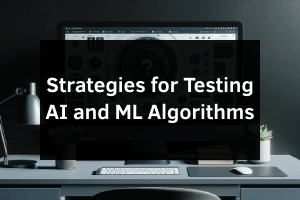-
Challenges
- Absence of Ground Truth: AI and ML models frequently generate predictions based on intricate patterns that defy easy human interpretation. This complicates the establishment of a definitive “ground truth” for testing. Unlike traditional software, where inputs and outputs have clear definitions, AI and ML model outputs can be probabilistic and continuous.
- Data Quality Issues: The quality and quantity of training data have a direct impact on AI and ML algorithm performance. Data may be tainted with biases, outliers, or missing values, potentially leading to biased or inaccurate models. The testing process must encompass data quality assessment and validation.
- Model Drift: AI and ML models can deteriorate over time due to changes in data distribution (concept drift). This means that a model that performed well during initial testing may no longer be accurate in a real-world setting. Continuous model monitoring and retraining are essential to tackle this challenge.
- Scalability and Performance Testing: AI and ML algorithms frequently need to handle large datasets and perform complex computations. It is crucial to test for scalability, performance, and resource utilization, particularly in production environments.
- Explainability and Interpretability: Understanding the rationale behind an AI or ML model’s predictions is crucial, especially in high-stakes domains like healthcare and finance. Black-box models can be challenging to interpret, making it difficult to diagnose and resolve issues.

-
Strategies for Testing AI and ML Algorithms
- Thorough Data Preparation: Ensure that training and testing datasets accurately represent real-world scenarios. Data preprocessing, cleaning, and augmentation should be integral to the testing process. The generation of synthetic data can be useful for creating diverse test cases.
- Baseline Establishment: Before deploying an AI or ML model, establish baseline performance metrics during development. This facilitates the monitoring of model performance over time and the detection of performance degradation.
- Continuous Testing and Monitoring: Implement continuous testing and monitoring within production environments. This includes setting up alerts for detecting model drift, data quality problems, and performance bottlenecks.
- Enhancing Model Explainability: Utilize techniques like LIME (Local Interpretable Model-agnostic Explanations) and SHAP (SHapley Additive exPlanations) to elucidate model predictions. Explainable AI tools can provide valuable insights into model behavior.
- Stress Testing: Conduct stress tests to evaluate how an AI or ML system behaves under extreme conditions. This encompasses testing under high loads, assessing resilience against adversarial attacks, and examining edge cases.
- Robustness Testing: Test the robustness of AI and ML models against various types of input data manipulation, including adversarial attacks and noisy data.
- Compliance and Ethical Testing: Ensure that AI and ML systems adhere to legal and ethical standards, particularly concerning data privacy, fairness, and bias mitigation.
- Collaboration Between Data Scientists and Testers: Foster collaboration between data scientists and testers throughout the development lifecycle. Testers should closely collaborate with data scientists to comprehend model behavior and potential failure modes.
CONCLUSION:
Testing AI and ML algorithms represents an ongoing process that demands a blend of conventional testing techniques and domain-specific approaches. By addressing the unique challenges and employing these strategies, organizations can construct more dependable and trustworthy AI and ML systems that meet the requirements of today’s data-driven world.
People having good knowledge of Financial accounting can get an Accounting Certification Exams from StudySection to increase their chances of getting a job in this field. You can get a foundation level certification if you are new to Financial accounting or you can go for advanced level certification if you have expert level skills in Financial accounting.




